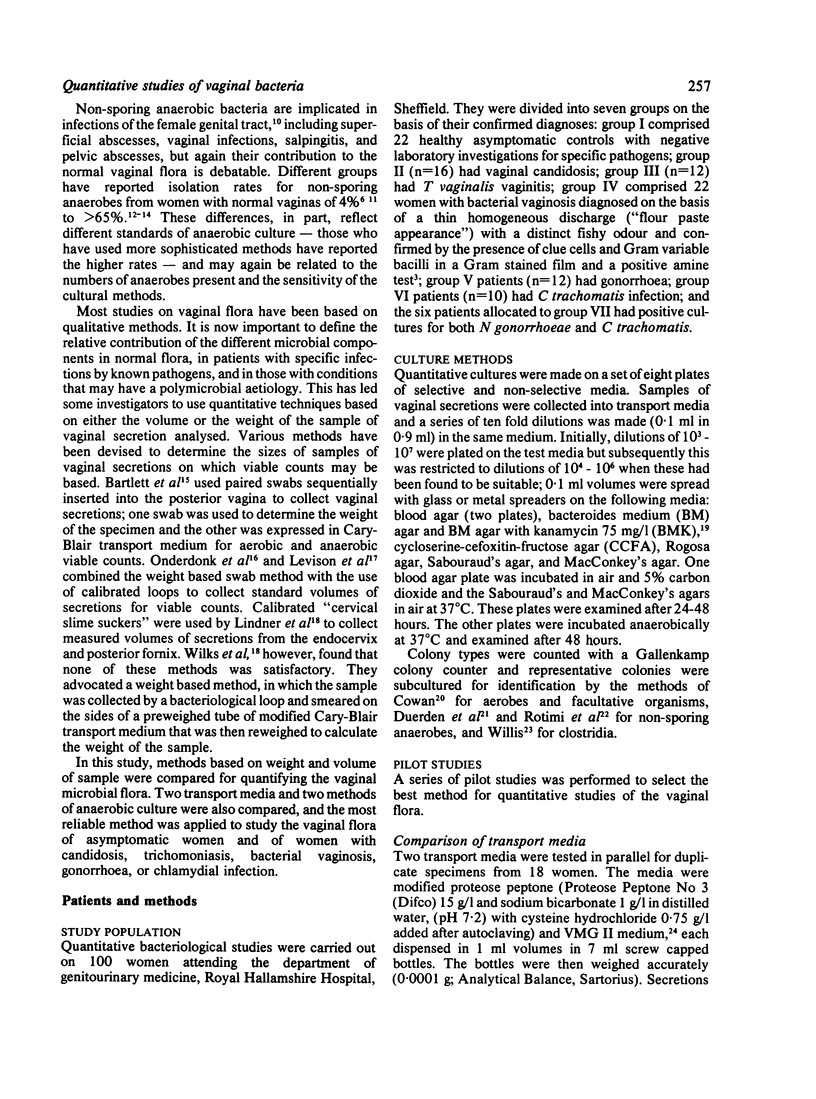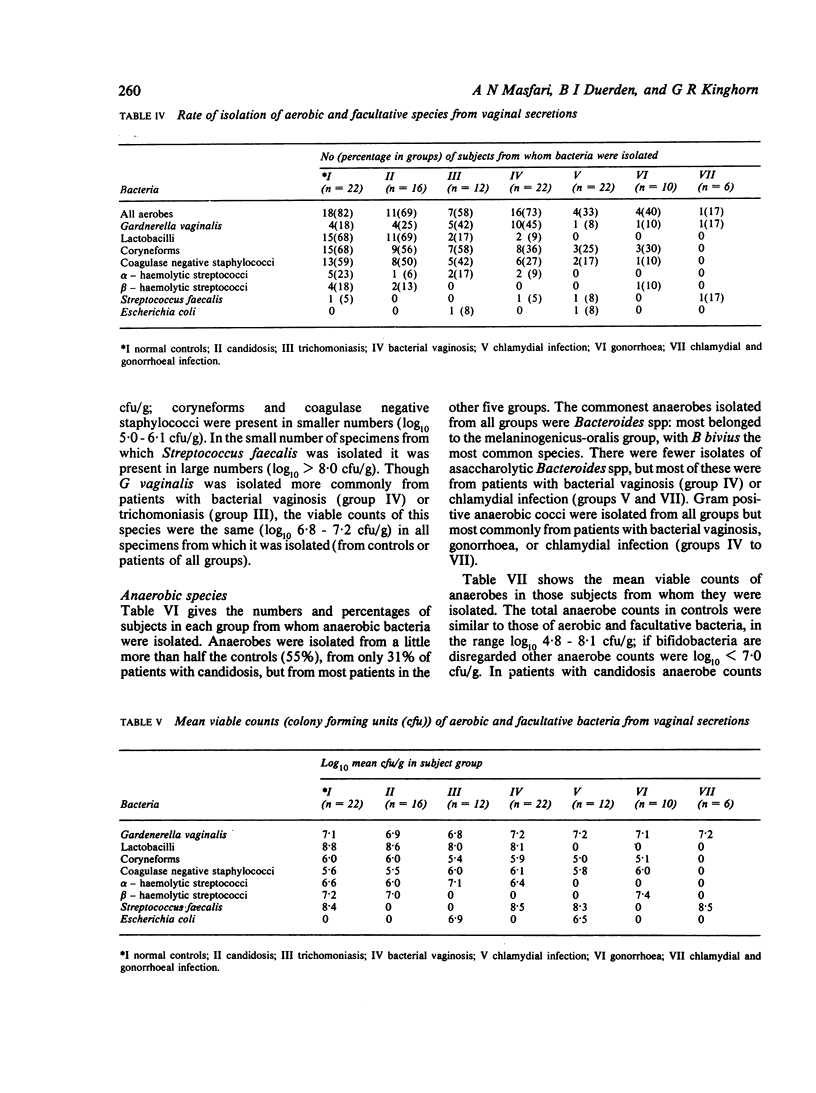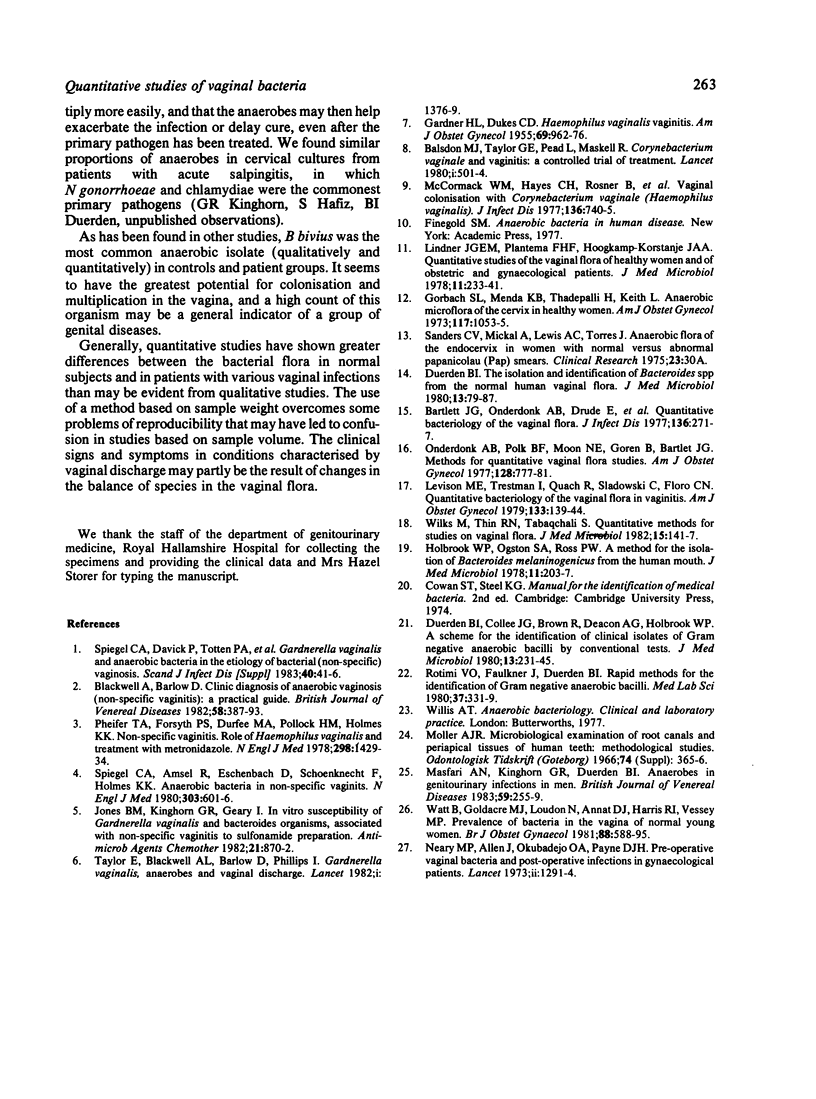Abstract
A quantitative method of culture, based on a weighed sample and with results expressed as colony forming units (cfu)/g was assessed and used to investigate the vaginal flora of normal women and that of women with vaginal disease. Samples were collected by means of disposable plastic loops into modified proteose peptone water transport medium in preweighed bottles. Counts expressed as cfu/g of secretion were consistent, whereas counts expressed as cfu/ml were inconsistent. Results obtained with specimens manipulated on the open bench were the same as those from duplicate samples processed in an anaerobic chamber. The normal vaginal flora was predominantly aerobic--lactobacilli, coryneforms, and coagulase negative staphylococci--with counts of greater than or equal to 10(8) cfu/g for lactobacilli. These were also present in patients with candidosis, but the flora in patients with trichomoniasis, bacterial vaginosis, gonorrhoea, or chlamydial infection was predominantly anaerobic. The commonest anaerobes were Bacteroides spp, particularly B bivius; they were found in 55% of controls but at counts of 10(2) cfu/g lower than in the patients, most of whom had high counts of anaerobes (greater than 10(8) cfu/g). The isolation rate of Gardnerella vaginalis was not appreciably greater from patients with bacterial vaginosis, and the quantitative cultures on controls and patients who were G vaginalis positive were the same (approximately equal to 10(7) cfu/g). Quantitative studies show greater differences than qualitative cultures between normal controls and patients with vaginal infections, indicating that some symptoms and signs of such infections may be related to quantitative polymicrobial changes.
Full text
PDF







Selected References
These references are in PubMed. This may not be the complete list of references from this article.
- Balsdon M. J., Taylor G. E., Pead L., Maskell R. Corynebacterium vaginale and vaginitis: a controlled trial of treatment. Lancet. 1980 Mar 8;1(8167):501–503. doi: 10.1016/s0140-6736(80)92762-2. [DOI] [PubMed] [Google Scholar]
- Bartlett J. G., Onderdonk A. B., Drude E., Goldstein C., Anderka M., Alpert S., McCormack W. M. Quantitative bacteriology of the vaginal flora. J Infect Dis. 1977 Aug;136(2):271–277. doi: 10.1093/infdis/136.2.271. [DOI] [PubMed] [Google Scholar]
- Blackwell A., Barlow D. Clinic diagnosis of anaerobic vaginosis (non-specific vaginitis). A practical guide. Br J Vener Dis. 1982 Dec;58(6):387–393. doi: 10.1136/sti.58.6.387. [DOI] [PMC free article] [PubMed] [Google Scholar]
- Duerden B. I., Collee J. G., Brown R., Deacon A. G., Holbrook W. P. A scheme for the identification of clinical isolates of Gram-negative anaerobic bacilli by conventional bacteriological tests. J Med Microbiol. 1980 May;13(2):231–245. doi: 10.1099/00222615-13-2-231. [DOI] [PubMed] [Google Scholar]
- Duerden B. I. The isolation and identification of Bacteroides ssp. from the normal human vaginal flora. J Med Microbiol. 1980 Feb;13(1):79–87. doi: 10.1099/00222615-13-1-79. [DOI] [PubMed] [Google Scholar]
- GARDNER H. L., DUKES C. D. Haemophilus vaginalis vaginitis: a newly defined specific infection previously classified non-specific vaginitis. Am J Obstet Gynecol. 1955 May;69(5):962–976. [PubMed] [Google Scholar]
- Gorbach S. L., Menda K. B., Thadepalli H., Keith L. Anaerobic microflora of the cervix in healthy women. Am J Obstet Gynecol. 1973 Dec 15;117(8):1053–1055. doi: 10.1016/0002-9378(73)90753-9. [DOI] [PubMed] [Google Scholar]
- Holbrook W. P., Ogston S. A., Ross P. W. A method for the isolation of Bacteroides melaninogenicus from the human mouth. J Med Microbiol. 1978 May;11(2):203–207. doi: 10.1099/00222615-11-2-203. [DOI] [PubMed] [Google Scholar]
- Jones B. M., Kinghorn G. R., Geary I. In vitro susceptibility of Gardnerella vaginalis and Bacteroides organisms, associated with nonspecific vaginitis, to sulfonamide preparations. Antimicrob Agents Chemother. 1982 Jun;21(6):870–872. doi: 10.1128/aac.21.6.870. [DOI] [PMC free article] [PubMed] [Google Scholar]
- Levison M. E., Trestman I., Quach R., Sladowski C., Floro C. N. Quantitative bacteriology of the vaginal flora in vaginitis. Am J Obstet Gynecol. 1979 Jan 15;133(2):139–144. doi: 10.1016/0002-9378(79)90464-2. [DOI] [PubMed] [Google Scholar]
- Lindner J. G., Plantema F. H., Hoogkamp-Korstanje J. A. Quantitative studies of the vaginal flora of healthy women and of obstetric and gynaecological patients. J Med Microbiol. 1978 Aug;11(3):233–241. doi: 10.1099/00222615-11-3-233. [DOI] [PubMed] [Google Scholar]
- Masfari A. N., Kinghorn G. R., Duerden B. I. Anaerobes in genitourinary infections in men. Br J Vener Dis. 1983 Aug;59(4):255–259. doi: 10.1136/sti.59.4.255. [DOI] [PMC free article] [PubMed] [Google Scholar]
- McCormack W. M., Hayes C. H., Rosner B., Evrard J. R., Crockett V. A., Alpert S., Zinner S. H. Vaginal colonization with Corynebacterium vaginale (Haemophilus vaginalis). J Infect Dis. 1977 Dec;136(6):740–745. doi: 10.1093/infdis/136.6.740. [DOI] [PubMed] [Google Scholar]
- Neary M. P., Allen J., Okubadejo O. A., Payne D. J. Preoperative vaginal bacteria and postoperative infections in gynaecological patients. Lancet. 1973 Dec 8;2(7841):1291–1294. doi: 10.1016/s0140-6736(73)92870-5. [DOI] [PubMed] [Google Scholar]
- Onderdonk A. B., Polk B. F., Moon N. E., Goren B., Bartlett J. G. Methods for quantitative vaginal flora studies. Am J Obstet Gynecol. 1977 Aug 1;128(7):777–781. doi: 10.1016/0002-9378(77)90720-7. [DOI] [PubMed] [Google Scholar]
- Pheifer T. A., Forsyth P. S., Durfee M. A., Pollock H. M., Holmes K. K. Nonspecific vaginitis: role of Haemophilus vaginalis and treatment with metronidazole. N Engl J Med. 1978 Jun 29;298(26):1429–1434. doi: 10.1056/NEJM197806292982601. [DOI] [PubMed] [Google Scholar]
- Rotimi V. O., Faulkner J., Duerden B. I. Rapid methods for identification of clinical isolates of Gram-negative anaerobic bacilli. Med Lab Sci. 1980 Oct;37(4):331–339. [PubMed] [Google Scholar]
- Spiegel C. A., Amsel R., Eschenbach D., Schoenknecht F., Holmes K. K. Anaerobic bacteria in nonspecific vaginitis. N Engl J Med. 1980 Sep 11;303(11):601–607. doi: 10.1056/NEJM198009113031102. [DOI] [PubMed] [Google Scholar]
- Watt B., Goldacre M. J., Loudon N., Annat D. J., Harris R. I., Vessey M. P. Prevalence of bacteria in the vagina of normal young women. Br J Obstet Gynaecol. 1981 Jun;88(6):588–595. doi: 10.1111/j.1471-0528.1981.tb01213.x. [DOI] [PubMed] [Google Scholar]
- Wilks M., Thin R. N., Tabaqchali S. Quantitative methods for studies on vaginal flora. J Med Microbiol. 1982 Feb;15(1):141–147. doi: 10.1099/00222615-15-1-141. [DOI] [PubMed] [Google Scholar]


